Meteorologists Confirm Record-High Arctic Temperature
A Siberian town shattered its record for June. The steady rise of the region's temperatures is playing a major role in climate change.
In June 2020, Verkhoyansk, Siberia recorded a temperature of 38 ºC during an unprecedented heatwave, confirmed by the WMO to be a record high for the region, with significant consequences for the area including widespread fires and Arctic sea ice loss. The WMO also recognized a new record-high temperature in Antarctica of 18.3 °C in February 2020, indicating that both poles are warming more quickly than the global average, prompting concerns about the changing climate.
On June 20, 2020, amid an unprecedented heatwave, the weather monitoring station in the Siberian city of Verkhoyansk detected a temperature of 38 ºC.
The United Nation’s World Meteorological Organization (WMO) has now confirmed the record-high for the region, exceeding the average temperature for June by 18 ºC.
This new Arctic record is one of a series of observations reported to the WMO Archive of Weather and Climate Extremes that sound the alarm bells about our changing climate.
“If you cast your mind back to last year, you will recall there was an exceptional, prolonged Siberian heatwave,” Clare Nullis, a WMO spokesperson, told a press conference in Geneva. “As a result of this heatwave, we saw devastating and very widespread Siberian fires, and we saw massive Arctic sea ice loss at the end of the summer season.”
See Also:Number of Extremely Hot Days Each Year Is Rising, BBC Report SaysVerkhoyansk is located on the Yena River, 115 kilometers north of the Arctic Circle. Its meteorological facilities started recording temperatures in 1885.
The WMO experts validated the reported record after confirming the means and procedures used by the facility to ensure correct measurements were taken.
The Siberian town, along with the entire region, explained the WMO, has “an extreme very harsh dry continental climate, very cold winter and hot summer.”
According to the WMO, that heatwave and its consequences played a significant role in making 2020 one of the three warmest years on record.
WMO experts said the new record should be considered a “snapshot” of a changing global scenario. They warned that even higher temperatures might be recorded in the future in the Arctic Circle, which is the 66.5° latitude line.
The heatwave that hit the Arctic had unique and severe characteristics, which led the U.N. agency to create a new category for record temperatures.
Listed in the Archive of Weather and Climate Extremes, the new category is titled “highest recorded temperature at or north of 66.5°, the Arctic Circle.” The new listing will help WMO and other experts around the world to better track the patterns of climate change in the polar area.
Both poles are now represented in the archive, which first listed temperature extremes in Antarctica in 2007.
“Fundamentally, this investigation highlights the increasing temperatures occurring for a climatically important region of the world,” said Randall Cerveny, rapporteur of climate and weather extremes for WMO.
“Through continued monitoring and assessment of temperature extremes, we can remain knowledgeable about the changes occurring in this critical region of the world,” he added.
See Also:Olive Oil Times Survey: Climate Change a Top Concern for ProducersLast July, the WMO recognized and confirmed a new record-high temperature in Antarctica: 18.3 °C, reported on February 6 by the Esperanza weather station in Argentina.
An even higher temperature – 20.7 °C was recorded on Seymour Island – but the WMO did not confirm the measurement carried out by an automated permafrost monitoring station.
During the investigation related to the Antarctic record, experts had determined that “a large high-pressure system over the area created föhn conditions, downslope winds producing significant surface warming, and resulted in local warming at both Esperanza Station and Seymour Island.”
Similar phenomena in the past had also produced record temperature scenarios in the area.
According to the WMO, both poles are warming more quickly than the global average. It is believed that the current pace of temperature rise in the Arctic is about double the global average.
“This new Arctic record is one of a series of observations reported to the WMO Archive of Weather and Climate Extremes that sound the alarm bells about our changing climate,” WMO Secretary-General Petteri Taalas concluded.
Share this article







